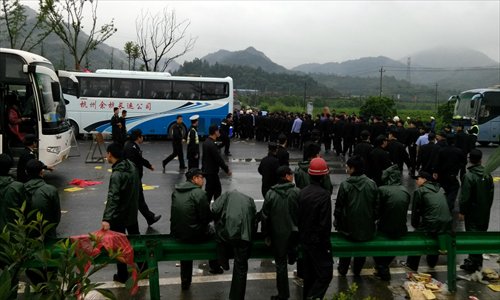

Police officers gather in the town of Zhongtai on May 11. Photo: Yang Hui/GT
Zhongtai, a town about 25 kilometers west of downtown Hangzhou, Zhejiang province, recently made national headlines after a protest against the construction of a trash incinerator on May 10, which was planned to be built at a former mine site in the district.
Following the protest, local authorities pledged the next day at a press conference that the Jiufeng incineration and power plant would not be built without receiving public support.
Over the weekend, local police detained 60 people involved in the clashes for violence or "rumor-mongering," said the Public Security Bureau of Hangzhou on Monday.
Fifty-three suspects, including 11 who turned themselves in to police, are in criminal detention for disturbing public order.
Seven people are in administrative detention for spreading rumors, according to the police.
But those arrest represent only a fraction of the thousands who rallied on Saturday. Protesters also rushed onto a section of the Hangzhou-Anhui highway, interrupting traffic.
At least 10 demonstrators and 29 policemen were injured as protesters blocked the highway, turning over and smashing dozens of cars, both police and private.
Traffic on the highway was back to normal in the late evening on Sunday, after the damaged cars were removed and protestors left away.
Shi Jianhua, a deputy head of the city's Yuhang district, said at the press conference that an environmental impact assessment of the project will be conducted. "Construction will not be started until it gains public support and legal approval," Shi said.
Smoky concerns
According to sources from the local government, the former Jiufeng mine site is a suitable place for building a waste-to-energy plant because it is located in a valley far from the residential areas but close to the highway.
However, this is not completely true. In fact, the site has four villages adjacent to it, with over 2,500 households and a total population of more than 8,000 people, according to the official figures from the Zhongtai town authorities.
Most of these residents live within a five-kilometer radius of the proposed plant site in the center. For some residents of Nanfeng village, the plant lies within a stone's throw of their houses.
"We have been living here for a long time. If the plant is built, we are afraid of the smell of trash and in the long term, we worry that the environment will be damaged, which will threaten our health," a villager surnamed Ma told the Global Times.
Ma said the site is near the administrative boundaries of two cities in Zhejiang Province, Hangzhou and Lin'an, meaning neither city's government really takes responsibility. As a result, the decision was made at the cost of nearby residents' interest.
There had been small protests since mid-April, after the project was put online to gather public opinion. Some 20,000 residents also signed a petition handed to the Hangzhou Urban Planning Bureau.
"However, the government did not respond well to the early protests, which escalated and turned violent on Saturday night, until armed police arrived to maintain order," Ma said.
In Ma's opinion, the local government did not provide enough information about the plant, so people take to the streets to ask for more.
The government's original planning showed that the Jiufeng incineration plant will burn and process 3,200 tons of trash on a daily basis after it finishes the first phase of construction, and it will be able to handle a total of 5,600 tons after the completion of the second phase.
The plant will help alleviate the problem of the increasing amount of trash produced in Hangzhou, which grows by about 10 percent annually. In 2013, the total amount of trash produced every day in Hangzhou reached 8,400 tons.
The trash burying site in Tianziling in the north of Hangzhou on peak days buries 5,408 tons of trash, more than double the amount that it was originally designed to process, said a report in China Business News.
Zhang Shukong, director of the solid waste disposal center at Hangzhou's urban management and law enforcement commission, said in the report that though 60 percent of local trash is buried, incineration is a normal method for trash disposal used by many cities.
Not in my backyard
"It is true that one of the ways to dispose trash is to burn it, but the question is always about where and how," Xie Yungeng, director of the Public Opinion Research Laboratory at Shanghai Jiao Tong University, told the Global Times.
Xie said the public is most concerned about the environmental impact of the trash incineration plants because most people believe that the incineration and disposal process will emit pollutants.
Advanced technology and strict emission criteria could ensure that the negative impact on the environment would be reduced to a minimum, but the public is still skeptical about whether the government will strictly supervise the incineration, said Xie.
In recent years, there have been 10 protests or riots about trash incineration, and three about trash disposal, all in large cities.
"There will be more such incidents in the future, because the public has a growing concern over the environmental problems with economic development," Xie predicted.
Xie also pointed out that it is a global problem as most residents are opposed to the idea of building a trash disposal plant close to their houses or residential areas.
One of the solutions is for the government to increase transparency and communicate more with the local residents, Xie said. "The government has to strike a balance between the public interest and the cost of various sides, and keep the public informed; otherwise, it will be too late when the incidents turn violent."
Copyright ©1999-2018
Chinanews.com. All rights reserved.
Reproduction in whole or in part without permission is prohibited.